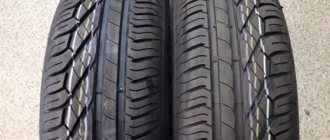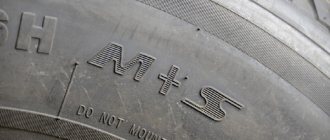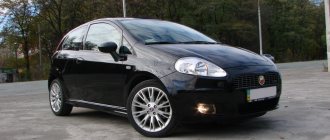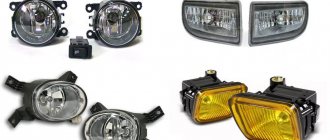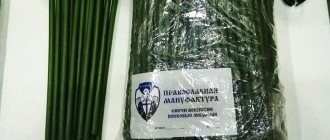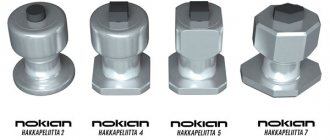Advantages of studs
In some European countries, spikes are prohibited - only Velcro is allowed
For a better illustration, we can take Finland as an example, where roads are never cleaned dry of snow and do not use reagents. At the most, Finns can sprinkle granite chips on the snow-covered track. This is where studded tires show themselves in all their glory. In combination with a snow-stone mixture, it works like sandpaper - it grinds the top layer, and then the tread comes into play.
Finns don’t drive on any other tires in winter—exclusively on studs! The main reason is ice, which forms on the surface of roads after snow rolls away and thaws in sunny weather. In general, they have a skating rink on the roads, and that’s all. Imagine turning an icy highway without a hint of our notorious sand-salt mixture. How will Velcro behave? That's right - it will slide into a ditch, dragging the car there. And on spikes you will go through such a turn without noticing any difficulties.
Thus, the main advantage of the studs is one thing - excellent performance in icy conditions. In this case, the following features are characteristic:
- vehicle stability;
- good grip of the wheels on the road surface;
- short braking distance.
On ice, studded tires will only benefit from light frost of -10...-20 degrees Celsius. And somewhere in Siberia, where the roads are not ice, but stone, it will not be easy for spikes to destroy it and catch on the road.
FROST AND SUN
In our tests, which have been carried out for more than a dozen winters (and the winters, of course, were different - from 30 degrees below zero to thaw), we periodically encountered this phenomenon. To finally give a clear answer to the question whether Velcro on ice can brake better than studs and if so, under what conditions, we conducted this study.
Of course, we were interested in the opinions of specialists from different companies, but we received rather cautious answers. Engineers from Continental and Michelin, for example, claim that the “equivalence” temperature of studded and non-studded tires is 15 degrees below zero. If it is warmer, studs are more effective on ice; if it is colder, Velcro is more effective. In this case, the condition of the ice and... the weather are very important. Rough ice helps Velcro, which cling to micro-irregularities, and on a glossy surface, spikes will cope with the task more successfully - this is obvious and does not require explanation. But the bright sun, even in cold weather, can slightly melt the ice and make it more slippery, primarily for Velcro. Therefore, in bright sun and clear ice, spikes may be better even at -20-25°C.
Watch your pressure! Unevenly inflated tires make the braking trajectory unpredictable.
Watch your pressure! Unevenly inflated tires make the braking trajectory unpredictable.
During the temperature test of summer tires (ZR, 2008, No., we gained some experience in such comparisons (by the way, leading tire companies were very interested in our results). Now let’s try to determine the effectiveness of studs and Velcro on ice at different temperatures. A real-life example - rolled out to a shine the section of road in front of the stop line...
we gained some experience in such comparisons (by the way, leading tire companies were very interested in our results). Now let’s try to determine the effectiveness of studs and Velcro on ice at different temperatures. A real-life example - rolled out to a shine the section of road in front of the stop line...
Tests took place in February - March 2008. They involved studs 195/65R15 and Velcro of a slightly larger size - 205/55R16. The slight difference does not affect our main task.
In the “clawed” group we included Michelin X-Ice North, known for its high stability of stud protrusion, and Continental ContiWinterViking 2 - it has wider studs. They selected opponents from new products, first of all promising not to be afraid of water on ice. These are Nokian Hakkapeliitta R, Michelin X-Ice 2 and Bridgestone Blizzak WS-60.
We will work on a Skoda Octavia car, braking from a speed of 50 to 5 km/h in order to eliminate errors in the operation of ABS (short-term wheel locking) at low speed.
To ensure that only the air temperature affected the condition of the ice, measurements were carried out in cloudy weather or after sunset, which could quickly melt the ice.
Pros of Velcro
Velcro maintains grip on the road thanks to the inclined arrangement of the slats
We live in Russia - this is the main argument when choosing winter tires. Unless, in the forgotten outback, you might need spikes to get out of the wilderness along an uncleaned snow-covered road or compacted ice. And closer to civilization, where road workers are more or less moving, the roads are scraped down to bare asphalt or at least generously strewn with reagents. On such a surface, one way or another wet, the spikes will act as skates - they will carry you off the road at the same speed as on Velcro in icy conditions. Even on dry and clean asphalt, Velcro holds traction better than studs, which also make a lot of noise if you are moving not on a snowy area, but on clean asphalt.
The colloquial name for friction tires “Velcro” appeared because of the main advantage - the ability to literally stick to the road surface. The rubber composition is selected in such a way that it remains elastic over a very wide temperature range. And the tread consists of so-called lamellas that have an individual pattern. Dirt and slush are instantly removed from the point of contact between the wheel and the road. Thanks to these qualities, friction tires work well on any surface and sometimes boldly compete with studded tires even on icy conditions.
FEEDBACK
We noticed that at first the subsequent braking performances of the Nokian Hakkapeliitta R on ice were better than the previous ones; the results stabilized only by the sixth attempt. It was assumed that this change in characteristics is due to the presence of special “containers” in the tread designed to remove water from the contact patch. When approaching the ice rink along a snowy road, snow falls into them. As a result, the car slips on snow grains, and after several passes the snow is shaken out of the tires and braking occurs on clean ice.
Nokian Tires specialists did not encounter such problems in their tests. But their tires were stored at above-zero temperatures (ours were in a cold container), and they were changed in a warm box. Warm tires easily clear snow when the car is driving along a snowy road towards an icy patch. It turns out that any car on these tires, after a long stay in the cold, will brake worse until they warm up.
To get rid of this effect, the designers decided to make the inner surface of the “pockets” smoother so that snow would not linger in them. To do this, the elements of the molds forming the walls of the “containers” were carefully polished. Before the comparative tests, the upgraded and conventional tires were kept in the cold, not in the heat. During the tests, a difference in braking distance of several meters was recorded - of course, in favor of the modernized ones.
Thus, not only our assumptions were confirmed, but also the effectiveness of the modernization. Since the end of April 2008, all Nokian Hakkapeliitta R and Hakkapeliitta R SUV tires come off the production line with smooth pocket walls. It’s nice that the magazine “Behind the Wheel” is responsible for this.
Test of spikes and Velcro on ice: Case of degrees
What and in what case is it better to choose
There is an opinion among Russian car enthusiasts that spikes are better than Velcro
Based on the above, the best winter option is friction tires, or, as they are popularly called, Velcro. Only if you cover most of your miles on snowy roads and ice, then you might consider studded tires. And in the city or on a highway that has been cleaned and treated with reagents, Velcro is the right choice.
Characteristics of winter tires
When purchasing winter tires, vehicle owners have to consider many more factors than when purchasing summer tires. First of all, you need to take into account the operating conditions of the car. Every car owner knows that there is no universal set of tires that would suit any weather conditions. However, with the help of many tests, their strengths and weaknesses can be identified.
Taking into account the results of such studies, the consumer can decide which option is most suitable for his case. Anyone wishing to acquire winter tires should study the characteristics of products presented in the table that have the appropriate marking.
| Designation | Properties |
| M+S | The studs are optimized for mud and snow, which is why the tires are often classified as all-season tires and are used to equip off-road vehicles. |
| All Season or AS | You can ride in any weather. |
| Snowflake pictogram | The tire is optimal only for winter driving. |
Most modern manufacturers use the TWI (Tread Wear Indiration) marking. It serves as an indicator of tread wear. A similar inscription on the wheel may also have the shape of an arrow, which indicates the minimum permissible depth.
This is interesting: Self-unloading of the engine
The main characteristic of tires of this type can be considered the speed index, which is associated with the softness of the tire rubber: the lower its value, the softer the tire rubber is, and wheels with such tires will have a greater coefficient of grip on winter roads. But such tires will wear out faster on hard surfaces.
Advantages of studded tires
Winter studded tires provide the desired grip on the road surface when driving in snowy weather. The tread of such tires should have a characteristic pattern, which will ensure the removal of snow mass from the contact zone. Such products are characterized by high grip characteristics due to the addition of a specific component to the rubber mixture. This allows you to maintain the desired properties even at very low temperatures.
The advantages of studded tires include:
- excellent traction on surfaces covered with ice and snow;
- good handling on slippery and snowy roads;
- short braking distance compared to other types of tires;
- confident maneuvering on slippery roads (taking turns).
The disadvantages of these tires include increased noise levels when driving and increased fuel consumption.
Improving grip performance leads to a decrease in vehicle controllability on dry surfaces.
The best studded tires
Studded winter tires are designed for use in harsh conditions that include ice and snow. All this is quite relevant for our road, both in large cities and beyond. Many car owners in cities prefer not to tempt fate, but to play it safe. For this purpose, they choose the “spike”. Let's look at the most popular winter tire models from this category, according to Swedish experts.
Nokian Hakkapeliitta 9
Optimally balanced parameters allowed us to achieve best-in-class performance for dry surfaces and snowy road surfaces. The product has proven itself well when used in any other conditions, and is also distinguished by the fact that it leads to a reduction in fuel consumption. Among the disadvantages, one can note only the increased noise level.
Continental IceContact 2
Having become the test leader from Finnish specialists, tires from the German manufacturer are distinguished by their long service life and excellent handling both on the street and on snowy roads.
Hankook Winter i*Pike RS+ W419D
South Korean products have a low price. Despite this, the tires showed excellent directional stability, as well as stable performance on all road surfaces.
Goodyear UltraGrip Ice Arctic
It features optimal dynamic characteristics for most driving situations. Reduced stability when changing road surfaces, as well as high noise at low speeds, prevented the vehicle from reaching the top three in the presented test.
Pirelli Ice Zero
Experts agreed that the rubber has relatively weak grip for driving on snow and ice. Despite this, the model closes the top five, which is due to the excellent performance of test drives on wet and dry roads. By purchasing such tires, car enthusiasts will notice a significant reduction in fuel consumption and minimal noise levels in all cases.
Michelin X-Ice North 3
A product of a French company, manufactured in the Russian Federation. Distinctive features of use are the predictable behavior of the vehicle, stable and safe response to changing conditions on the road. It is worth paying attention to the fact that the tires from this manufacturer have a small number of studs, which led to poor performance on ice.
Tire studding
There are currently four types of studs:
- Round . The simplest and cheapest type of studs, which is installed on most winter tires. The only advantage of such spikes is their low cost. The main disadvantage is the low degree of adhesion to icy road surfaces.
- Oval . A more advanced type of studs that provide a larger area of contact between the tire and the road surface, thereby increasing the degree of traction and reducing the possibility of slipping. In addition, tires with such studs have a lower noise level than tires with round studs. Accordingly, the price tag for such tires will be higher.
- Tetrahedral. Exclusive studs developed by Nokian. These studs have edges and sharp edges that allow them to “cut” into the ice surface and provide excellent traction. The fastening of such studs is very reliable, which will allow you to use the tires for many seasons. Of course, you will have to pay a lot of money for quality
- Hexagonal (diamond). These studs are equipped with even more edges than tetrahedral ones, therefore they provide even better grip. The disadvantages of these spikes include rapid abrasion of the edges and the highest price.
This is interesting: Replacing the ignition switch contact group in 6 steps
Most studs are single-flange with one retaining element and a body of varying shapes. There are also double-flange studs, which are less common, but are characterized by high resistance to falling out. These studs are equipped with an additional flange that better holds the element in the tire.
Which winter tires are better: studs or Velcro? Preparing the car for winter
There is a lot of debate among car enthusiasts about which winter tires are better: studs or Velcro. Some argue in favor of the first, others in favor of the second. And sellers sometimes mislead car owners by offering something that is not at all what they need. Today we will try to give drivers a definitive answer to the question of which winter tires are better: studs or Velcro.
Review of studless tires
This rubber is often called Velcro, but many beginners have no idea what it is. And everything is quite simple. Thanks to the special soft tread, this tire seems to stick to the road surface, providing the car with maximum grip on the road. Hence the name "Velcro". Before giving a precise answer to the question “which winter tires are better: studs or Velcro,” let’s look at all the pros and cons of studless wheels.
So let's start with the benefits. The main advantage of Velcro is its noiselessness. On any road surface, be it bare asphalt or ice, there is no constant hum or vibration in the car. A car with such tires consumes much less fuel than one equipped with studded tires. Driving such a vehicle is much more convenient and safer, especially on cleared asphalt. And another plus is free entry into the countries of the European Union. The fact is that in many European countries it is prohibited to use studded tires on cars and trucks, since most roads are regularly cleared of snow, and accordingly, the studs will damage the upper part of the asphalt.
But Velcro also has disadvantages. This is, first of all, an increased braking distance, as well as less controllability on loose and compacted snow.
Which winter tires are better: studs or Velcro? Studded Wheels Review
This tire appeared much earlier than the one described above. Its main advantages are effective braking on ice and safe cornering. The studs provide the car with excellent traction during sudden braking and acceleration. In addition, they perform more efficiently in the snow.
As for the disadvantages, drivers first of all note the high noise level. Inside, you can constantly hear the characteristic sound of the wheels touching the road. In addition, drivers feel a slight vibration on the steering wheel, which causes them great discomfort on long trips. Fuel consumption, whatever one may say, will be 5-10 percent more. And one more thing - the fragility of the thorns. They tend to wear off and fly out when hitting a cleared asphalt surface. Because of this, the service life of such wheels does not exceed 2-3 seasons (the first type of tire can withstand up to 5 seasons).
So what should you choose? Are spikes or Velcro better?
Of course, if you live in a big city where the roads are regularly cleared of snow, choose non-studded tires. On the other hand, you will simply lose all the thorns in a week or two. Well, if you often drive through uncleared areas, buying studded tires would definitely be a smart decision.
As you can see, the answer to the question “which is better: Velcro tires or studs” directly depends on the terrain in which you operate the car.
The best models of winter tires with Velcro
#10. Kumho Marshal I'Zen RV Stud KC16
In tenth place, among the sales leaders, are Kumho Marshal I'Zen RV Stud KC16 tires. The company's production is aimed at Western markets, and has a branch in the UK. Even though this brand occupies only tenth place, it is the most common among many car enthusiasts, and leaves many tires far behind.
#9. Continental Conti 4×4 Winter Contact
The non-standard tread pattern allows the Continental Conti 4×4 Winter Contact to very effectively clear snow and dirt from sticking to them, thanks to the transverse grooves. Due to the relief pattern of the tire, good stability is ensured. Among the main advantages, it is worth noting the ability to travel on country roads covered with a thick layer of snow or a dense ice crust.
#8. Hankook DynaPro i*cept RW08
In eighth place, quite solidly, is another representative, released in Korea, which is rapidly conquering markets around the world, these are Hankook DynaPro i*cept RW08 . The tires have good grip on icy surfaces and cope well with snow-covered roads. They also have good acoustic properties and a very reasonable price.
#7. Yokohama Geolandar I/TS G073
The seventh line is occupied by Japanese-made tires Yokohama Geolandar I/TS G073 . Tests have shown that using these tires you can easily climb a small hill, even if it is covered with a small layer of ice. When making sharp turns or braking, like most Velcro, it tends to slip and make involuntary drifts. Doesn't perform well on ice.
#6. Nokian Nordman RS2
Nokian Nordman RS2 tires has clear lines, which allows you to remove dirt and snow from the bottom of the car. The rib located in the center of the tire guarantees increased wear resistance. The slats are developed using a special technology, thanks to which the grooves are located one inside the other. This design can significantly improve traction, minimize slipping, and in most cases, eliminate tire deformation while driving.
